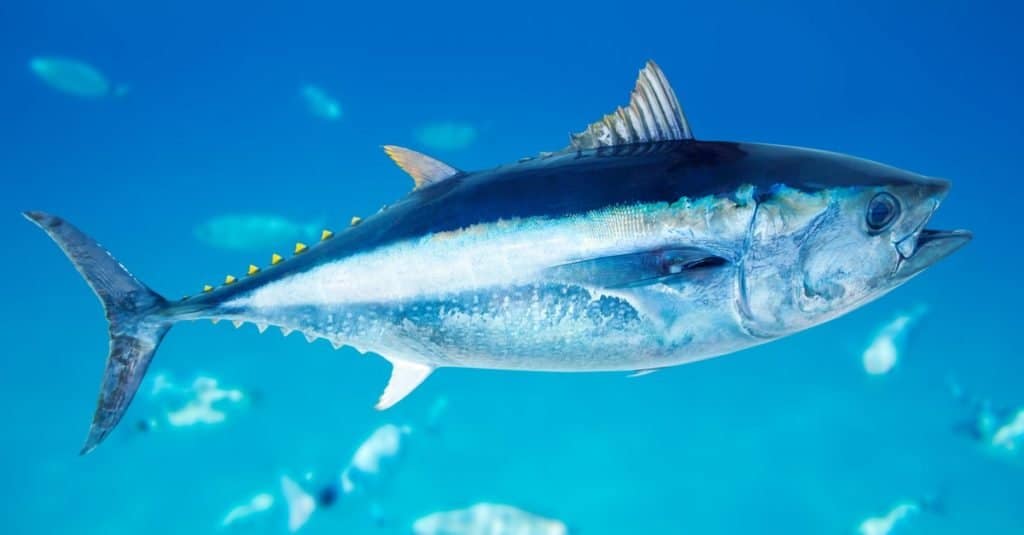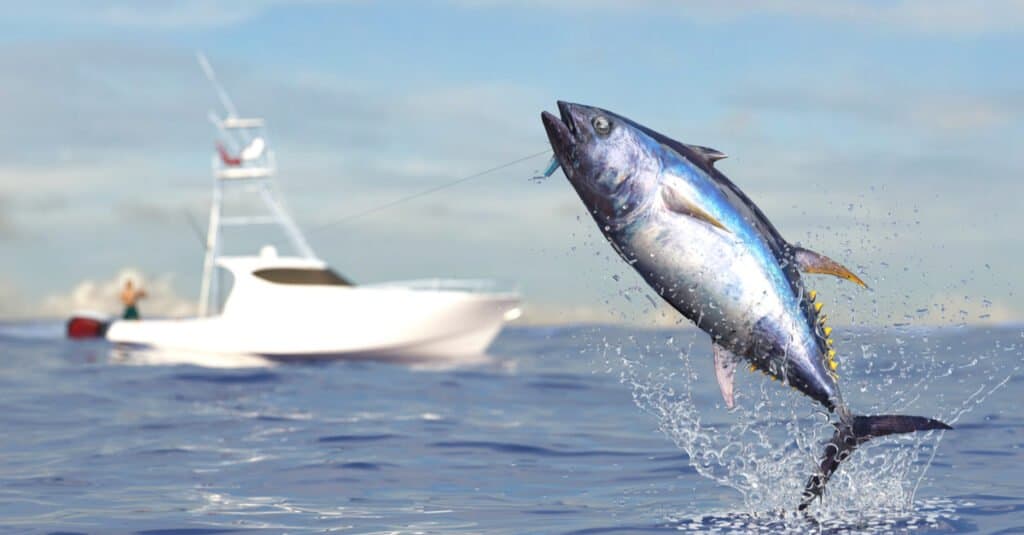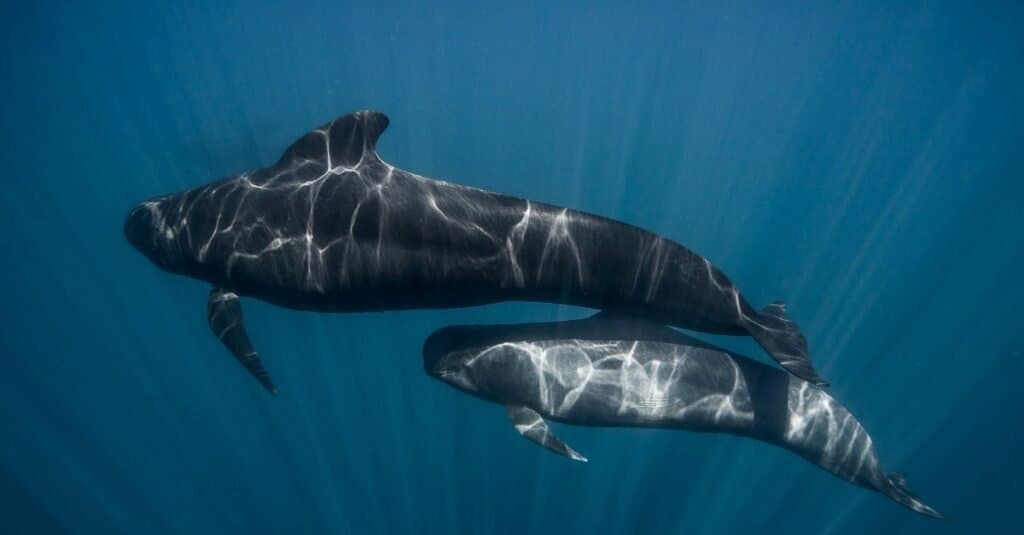If you have tuna melts on your dinner menu you are probably going to crack open a delicious can of tuna. These little cans are typically 12 oz of tuna, but did you know that tuna are actually enormous fish? The tuna you may be eating for your sandwich comes from skipjack, yellowfin or albacore tuna. An albacore can grow to be 75 lbs! But that is one of the smaller species of tuna. Yellowfin tunas are another common tuna used for canned tuna and they can weigh as much as 400 lbs. Sounds impressive, but these are still not the largest tuna on earth. Have you ever wondered how much the largest tuna ever caught weighs? What kind of tuna it is? Let’s find out about the largest bluefin tuna ever caught.
The Largest Tuna Species Is the Atlantic Bluefin Tuna

The Atlantic bluefin tuna can reach more than 1,000 pounds and speeds of more than 40 miles per hour.
©lunamarina/Shutterstock.com
The Atlantic bluefin tuna is the largest tuna species in the world.
There are 15 species of tuna in the Scombridae family (which includes tuna and mackerel). The largest species in this family is the Atlantic bluefin tuna. They are metallic-looking in colors of dark blue and black and have long powerful bodies. These ocean-dwelling fish vary greatly in size but are known for their impressive speed in the water. Their streamlined bodies can reach up to 43 mph which is pretty impressive for a fish that can grow up to 15 feet! Atlantic bluefin are also called northern bluefin or giant bluefin and live in the western Atlantic Ocean from Newfoundland down to the Gulf of Mexico. They are migratory and can cover great distances during migration.
How Much Does a 15 ft Atlantic Bluefin Tuna Weigh?
Atlantic Bluefin can weigh as much as 1,500 lbs (more on this below)! That means the tuna is about as heavy as a cow! The 15 ft and 1,500 lbs tuna are at the large end of the scale with most Atlantic Bluefin being closer to 500-1000 lbs.
How Big Was the Largest Bluefin Tuna Ever Caught?

The biggest tuna caught weighed 1,496 pounds.
©bekirevren/Shutterstock.com
The largest bluefin ever caught weighed an incredible 1,496 lbs!
You may have heard of the reality TV show called “Wicked Tuna” that follows a group of tuna fishermen from Massachusetts. There have been at least 10 seasons and during all those years the biggest tuna ever caught by anyone on the show was a 1,250 lbs bluefin off the coast of Cape Cod. It was nearly 10.5 feet and was caught by TJ Ott.

BUT this was not the largest tuna ever caught! There is a long-standing, almost 40-year record held by Ken Fraser who caught the largest bluefin tuna ever recorded back in 1979. The bluefin he caught weighed 1,496 lbs!
Ken Fraser and Captain Eric Samson were fishing off the coast of Nova Scotia, and it took them only 45 minutes to reel in this record-setter close enough to spear it with a gaff. Some tuna weighing more than 1,000 lbs have been recorded since this mighty catch but none have topped the 1,496 lb record.
Where Is Nova Scotia Located on a Map?
Nova Scotia is in Canada, situated south of Prince Edward Island. The Isthmus of Chignecto, which the land border with New Brunswick is located on, links the Nova Scotia peninsula to North America. West of Nova Scotia is the Bay of Fundy and Gulf of Maine. The Atlantic Ocean is to its south and east.
How Do You Catch a 1,500 lb Tuna?
The most common fishing method for U.S. fishermen is the rod and reel where they fish for one tuna at a time. They will use bait to attract the tuna and then with short lines and hooks try to catch one and reel it in close to the boat where they can gaff or harpoon it before pulling it into the boat. Isn’t it amazing that the biggest tuna ever caught was with a rod and reel?
What Are Other Ways to Catch Tuna?

Tuna travel in large schools.
©Guido Montaldo/Shutterstock.com
Tuna like to swim in schools so fishermen may come across large groups of tuna at a time. Fishermen used to pull large nets behind their boats and snag whatever was in the water, pull the nets up and keep the large tuna and throw the rest of the catch (bycatch) back in the water. However, this resulted in a large number of dolphins being injured and killed. Dolphins often swim above schools of yellowfin tuna and fishermen would use these dolphin sightings to locate the tuna. There were marine life protection guidelines in place, but change didn’t occur until a biologist, Sam LaBudde, went undercover and videotaped the netting practices showing dolphins being captured, and then released the videos to the public. People were outraged by what they saw and demanded change. This was the beginning of the “Dolphin-Safe” labels for tuna that were regulated by the Dolphin Protection Consumer Information Act in 1990.
Fun Facts About Tuna

Tuna and sardines are different species.
©Al McGlashan/Shutterstock.com
The albacore tuna has the largest pectoral fins. The pectoral fins are the fins on the side of a fish that are right behind their head. Fish and tuna alike use these fins to help control their direction in the water. Albacore tuna can grow to be 7 feet long and their pectoral fins can be 30% of their total length! Albacore tuna are frequently used to make canned tuna, sometimes labeled as “solid white albacore” tuna.
The bigeye tuna has the largest eyes. I guess their name kind of gives it away, but the bigeye tuna does have big eyes! Bigeye tunas can grow to be 5 ½ feet long. Although there is not a world record for the largest bigeye “eye” they do have the largest eyes of all of the tuna. Take a look at a picture of a proud fisherman holding their catch to see just how big their eyes are!
The blackfin tuna is the smallest tuna in the Thunnus family. Compared to a 1000lb Bluefin, these tuna are tiny, but they can still reach 3 feet long and weigh 45 lbs or more. They are easily distinguished by a long black strip on their topside. Blackfin tuna is used to make sushi and can be eaten raw, but it is also used as bait to catch larger tuna.
Are sardines just tiny tuna? No, sardines are fish in a different family. They belong to the Clupeidae family along with herrings and shads. Sardines only get to be 6-12 inches and typically weigh 3 ounces to 7 lbs. The largest sardine ever caught was from India and was 272 mm and weighed 159g. That is not quite a foot and .35lbs makes for quite a less impressive photo-op.
What Do Atlantic Bluefin Tuna Eat?

Pilot whales are one of the few predators of Atlantic bluefin tuna.
©iStock.com/eco2drew
Atlantic bluefin tuna have only a few predators. They travel in large schools and have big appetites due to the fact that they are actually warm-blooded fish. To keep their body temperatures up, they must stay in constant motion. Bluefin tuna feed on crustaceans, squid, and fish like bluefish, herring, and mackerel.
Predators of bluefin tuna include sharks, orca, killer whales, pilot whales, and seabirds, who will prey on juveniles.
The photo featured at the top of this post is © bekirevren/Shutterstock.com
Thank you for reading! Have some feedback for us? Contact the AZ Animals editorial team.







